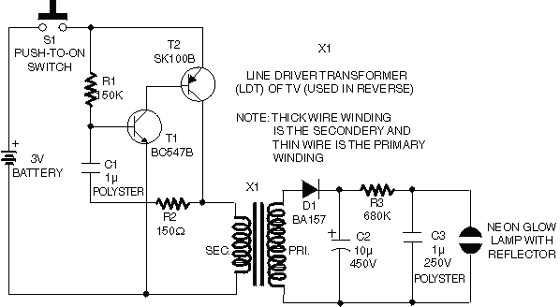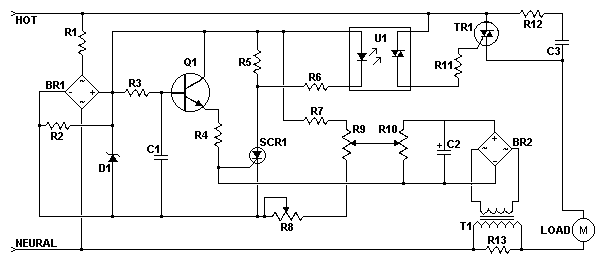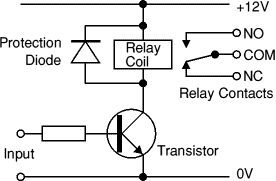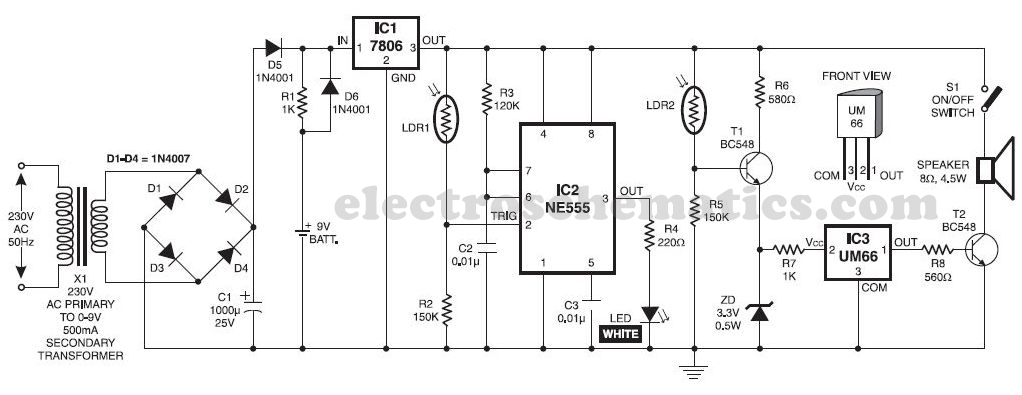
Voltage Regulator Using Zener Diode Circuit
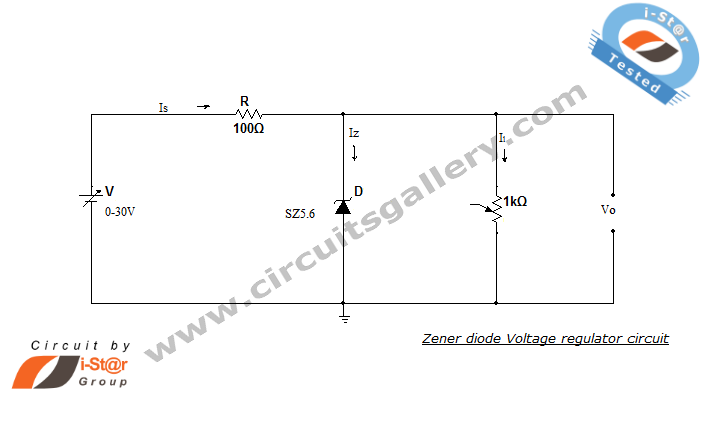
A Zener diode regulator is a fundamental electronic circuit valuable for hobbyists. This circuit provides a regulated output voltage, suitable for biasing other circuit components. The Zener diode operates in the reverse breakdown region, maintaining a nearly constant voltage regardless of the current flowing through it. The primary advantage of using a Zener diode as a voltage regulator is the reduction in the need for bulky and expensive DC power sources. To construct a Zener voltage regulator, the circuit consists of a Zener diode and a passive electronic component, typically a resistor, with an active power supply source. This type of regulator is also referred to as a Zener voltage limiter due to its ability to regulate voltage despite variations in current through the Zener diode. If the input voltage decreases, the load current (IL) remains constant, while the Zener current (IZ) and source current (IS) decrease. Should IZ fall below the minimum Zener current required to maintain the diode in the breakdown region, regulation ceases, resulting in a drop in output voltage.
The Zener diode voltage regulator circuit typically includes a Zener diode connected in parallel with the load and a series resistor that limits the current flowing through the Zener diode. The resistor is crucial as it determines the maximum current that can flow through the Zener, ensuring that it operates within its specified limits. When designing this circuit, it is essential to select a Zener diode with a breakdown voltage that matches the desired output voltage. The series resistor value can be calculated using Ohm's law and the Zener diode specifications, taking into account the maximum input voltage and the desired load current.
In operation, when the input voltage is applied, the Zener diode enters the breakdown region and clamps the output voltage to its specified value. This regulation occurs as long as the current through the Zener remains above the minimum required level. If the load draws more current than the Zener can supply while remaining in breakdown, the output voltage will drop, indicating a failure in regulation. Therefore, proper sizing of the resistor and selection of the Zener diode are critical for ensuring reliable performance.
Additionally, the circuit's performance can be affected by temperature variations, as the Zener voltage can drift with temperature changes. It is advisable to consider temperature coefficients when selecting Zener diodes for precision applications. Overall, the Zener diode voltage regulator is a simple yet effective solution for providing stable voltage in various electronic applications, particularly in low-power scenarios where minimal components are desired.Zener diode regulator is a basic electronic circuit which is very useful for those interested in hobby circuits. This circuit is used for obtaining a regulated voltageat the output which can be used for biasing other circuit elements.
Now how to use zener diode as voltage regulator When zener is in reverse breakdown region, the zener voltage remai ns almost constant irrespective of the current through it. The major benefit of using zener diode as a voltage regulator is that it helps us to avoid the bulky&costly DC source to a great extend. Now lets see how to make a ZENER VOLTAGE REGULATOR. The circuit only contains a zener diode and passive electronic element- resistor. Active source is provided for power supply to the circuit. Zener voltage regulator is also known as Zener voltage limiter due to its voltage regulation property irrespective of the current through the zener diode.
If input voltage decreases, IL remains the same. Iz &Is decreases. If Iz falls lower than minimum zener current required to keep the Zener in breakdown region, the regulation will stop and voltage at output will decrease. 🔗 External reference
The Zener diode voltage regulator circuit typically includes a Zener diode connected in parallel with the load and a series resistor that limits the current flowing through the Zener diode. The resistor is crucial as it determines the maximum current that can flow through the Zener, ensuring that it operates within its specified limits. When designing this circuit, it is essential to select a Zener diode with a breakdown voltage that matches the desired output voltage. The series resistor value can be calculated using Ohm's law and the Zener diode specifications, taking into account the maximum input voltage and the desired load current.
In operation, when the input voltage is applied, the Zener diode enters the breakdown region and clamps the output voltage to its specified value. This regulation occurs as long as the current through the Zener remains above the minimum required level. If the load draws more current than the Zener can supply while remaining in breakdown, the output voltage will drop, indicating a failure in regulation. Therefore, proper sizing of the resistor and selection of the Zener diode are critical for ensuring reliable performance.
Additionally, the circuit's performance can be affected by temperature variations, as the Zener voltage can drift with temperature changes. It is advisable to consider temperature coefficients when selecting Zener diodes for precision applications. Overall, the Zener diode voltage regulator is a simple yet effective solution for providing stable voltage in various electronic applications, particularly in low-power scenarios where minimal components are desired.Zener diode regulator is a basic electronic circuit which is very useful for those interested in hobby circuits. This circuit is used for obtaining a regulated voltageat the output which can be used for biasing other circuit elements.
Now how to use zener diode as voltage regulator When zener is in reverse breakdown region, the zener voltage remai ns almost constant irrespective of the current through it. The major benefit of using zener diode as a voltage regulator is that it helps us to avoid the bulky&costly DC source to a great extend. Now lets see how to make a ZENER VOLTAGE REGULATOR. The circuit only contains a zener diode and passive electronic element- resistor. Active source is provided for power supply to the circuit. Zener voltage regulator is also known as Zener voltage limiter due to its voltage regulation property irrespective of the current through the zener diode.
If input voltage decreases, IL remains the same. Iz &Is decreases. If Iz falls lower than minimum zener current required to keep the Zener in breakdown region, the regulation will stop and voltage at output will decrease. 🔗 External reference
